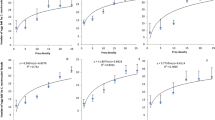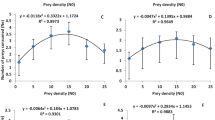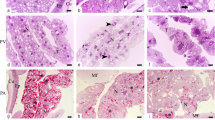Abstract
Avermectin at 1 ppm was slightly toxic by contact to the different immature stages of the predacious miteAmblyseius gossipi El-Badry. When immatures ofA. gossipi ingested treated prey on clean leaf discs, the toxicity increased and the resulted ΦΦ oviposited at a significantly lower rate. In contrast, dicofol at 250 ppm was extremely toxic by contact and caused a significant mortality to the immatures when it was ingested. Female mortality increased and fecundity decreased as the time of feeding treated prey increased from 24 h to 192 h. In case of dicofol a permanent depression in reproduction was recorded after feeding treated prey for 144 h.
Females ofA. gossipi suffered a depression in reproduction when fed on prey formerly kept on plant leaves treated with avermectin. This depression was reported, only, after 192 h of feeding on prey previously reared on leaves treated with dicofol.
Résumé
L'avermectin à la dose de 1 ppm était légèrement toxique par contact vis-à-vis des différents stades immatures de l'Acarien prédateurAmblyseius gossipi El-Badry. Quand les stades immatures d'A. gossipi absorbaient des proies traitées sur des disques de feuilles propres, la toxicité augmentait et les femelles en résultant pondaient moins.
Par opposition, le dicofol à la dose de 250 ppm étiat extrêmement toxique par contact et provoquait une mortalité significative chez les stades immatures qui l'absorbaient. La mortalité des femelles augmentait et leur fécondité décroissait à mesure que le temps de prédation des proies traitées augmentait de 24 à 192 h. Dans le cas du dicofol, une réduction permanente de la reproduction s'observait après 144 h d'alimentation sur proies traitées.
Les femelles d'A. gossipi manifestaient une chute de reproduction quand elles étaient nourries de proies gardées antérieurement sur des feuilles traitées à l'avermectin. Cette chute n'était signalée qu'après 192 h d'alimentation sur proies antérieurement sur feuilles traitées au dicofol.
Similar content being viewed by others
References
Abou-Awed, B. A. &El-Banhawy, E. M. — 1985. Comparison between the toxicity of synthetic pyrethroids and other compounds to the predacious miteAmblyseius gossipi [Mesostigmata: Phytoseiidae]. —Exp. Appl. Acarol., 1, 185–191.
El-Banhawy, E. M. — 1976. Residual toxicity of some common acaricides in Brazil to the predacious mite,Amblyseius brazilli. —Entomophaga, 21, 303–306.
El-Banhawy, E. M. — 1977. Growth inhibition of the predacious miteAmblyseius brazilli [Mesostigmata: Phytoseiidae] by a synthetic juvenile hormone under laboratory conditions. —Entomophaga, 22, 429–434.
El-Banhawy, E. M. — 1978. Toxicity of fentrifanil, a selective acaricide, to the predacious miteAmblyseius brazilli and its preyTetranychus desertorum. — 4th Conf. Pest control, National Research Centre, Cairo, pp. 855–856.
El-Banhawy, E. M. &Anderson, T. E. — 1985. Effects of avermectin B1 and fenvalerate on the survival, reproduction, and egg viability of the two spotted spider miteTetranychus urticae Koch [Acari: Tetranychidae]. —Int. J. Acarol., 10, 11–16.
El-Banhawy, E. M. &El-Bagoury M. E. — 1985. Toxicity of avermectin and fenvalerate to the eriophyid gall miteEriophyes dioscoridis and the predacious mitePhytoseius finitimus [Acari: Eriophyidae; Phytoseiidae]. —Int. J. Acarol., 11, 237–240.
Grafton-Cardwell, E. &Hoy, M. A. — 1983. Comparative toxicity of avermectin B1 to the predatorMetaseiulus occidentalis (Nesbitt) [Acari: Phytoseiidae] and the spider mitesTetranychus urticae Koch andPanonychus ulmi (Koch) [Acari: Tetranychidae]. —J. Econ. Entomol., 76, 1216–1220.
Hoy, M. A. &Cave, F. E. — 1985. Laboratory evaluation of avermectin as a selective acaricide for use withMetaseiulus occidentalis (Nesbitt) [Acarina: Phytoseiidae]. —Exp. Appl. Acarol., 1, 139–152.
Jeppson, L. R., McMurtry, J. A., Mead, D. W., Jesser, M. J. &Johnson, H. G. —1975. Toxicity of citrus pesticides to some predacious phytoseiid mites. —J. Econ. Entomol., 68, 707–710.
Nakashima, M. J. &Croft, B. A. — 1974. Toxicity of Benomyl to the life stages ofAmblyseius fallacis. —J. Econ. Entomol., 67, 675–677.
Putter, I., McConnell, J. G., Preiser, F. A., Haidri, A. A., Ristich, S. S. &Dybas, R. A. — 1981. Avermectins: novel insecticides, acaricides, and nematicides from a soil microorganism. —Experientia, 37, 963–964.
Rasmy, A. H. &El-Banhawy, E. M. — 1972. Susceptibility of the predatory mitePhytoseius plumifer [Acarina: Phytoseiidae] to some acaricides. —Appl. Entomol. Zool., 7, 176–177.
Author information
Authors and Affiliations
Rights and permissions
About this article
Cite this article
Reda, A.S., El-Banhawy, E.M. Effect of avermectin and dicofol on the immatures of the predacious miteAmblyseius gossipi with a special reference to the secondary poisoning effect on the adult female [Acari: Phytoseiidae]. Entomophaga 33, 349–355 (1988). https://doi.org/10.1007/BF02372625
Received:
Accepted:
Issue Date:
DOI: https://doi.org/10.1007/BF02372625




